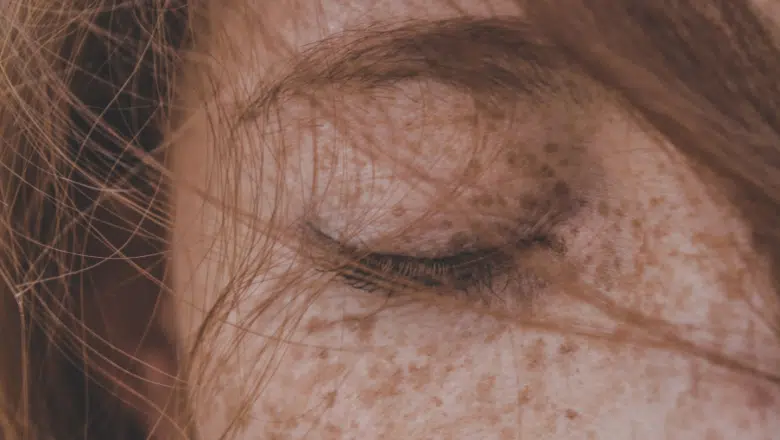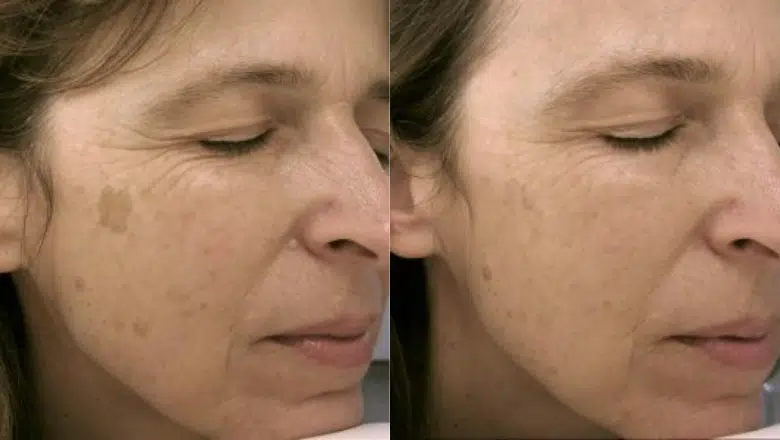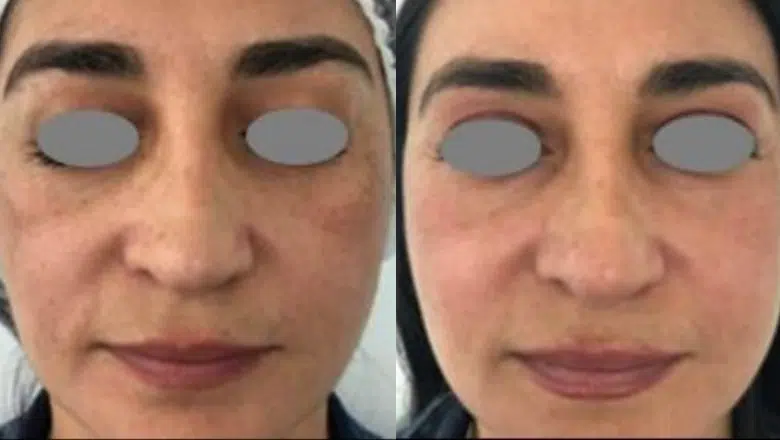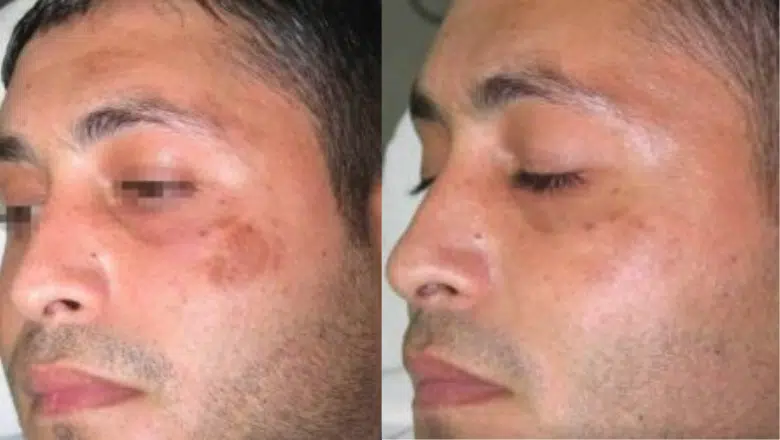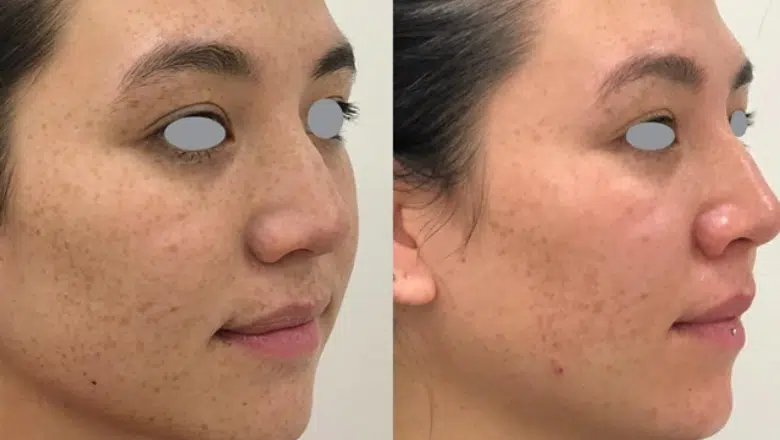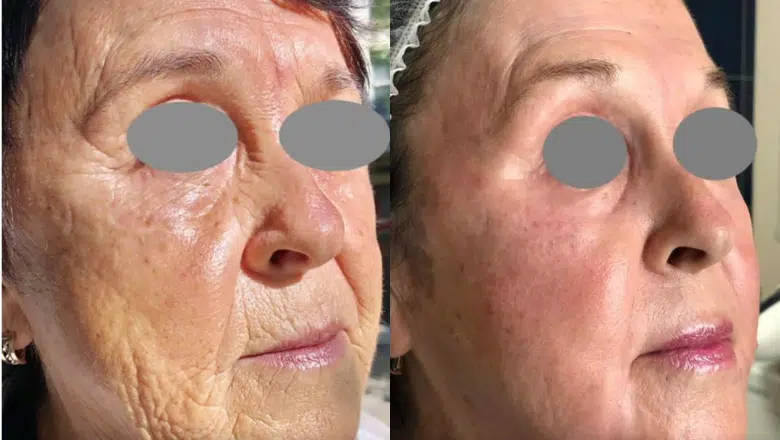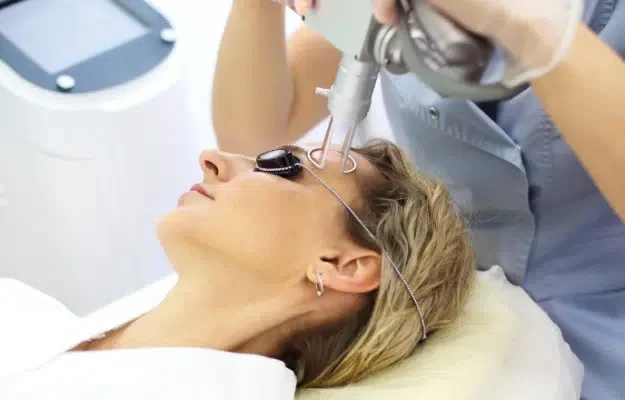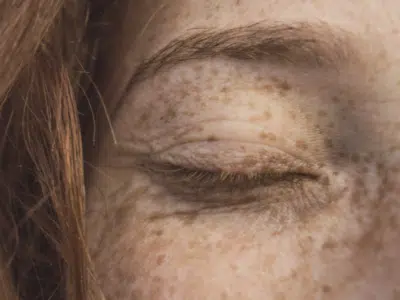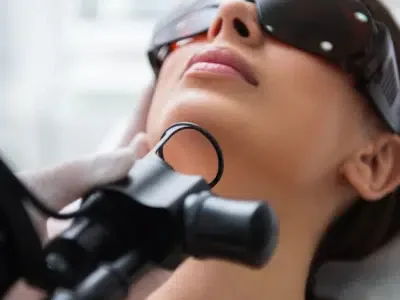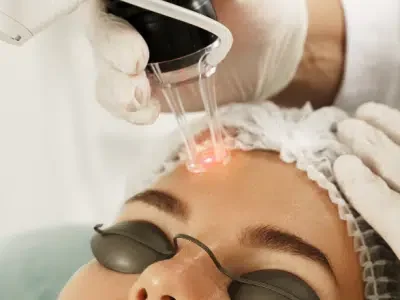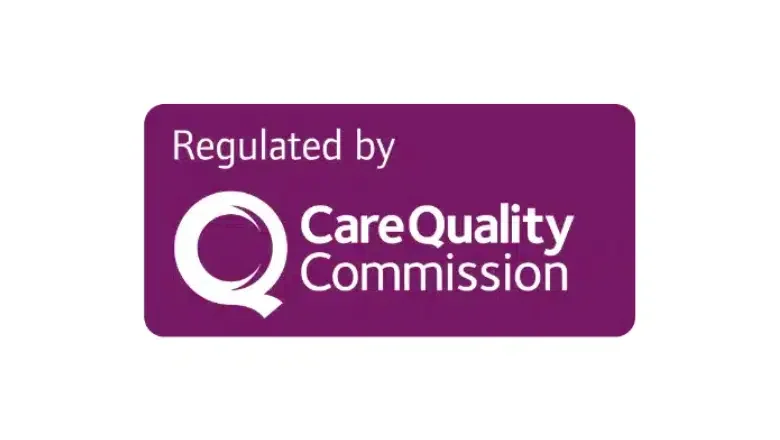Hyperpigmentation is a very common skin complaint involving areas of skin that become darker in appearance compared with that of the surrounding skin. Melanocytes are the skin pigment-producing cells of the body and are responsible for the appearance of darker patches through the over-production of melanin. Excessive production of melanin leads to an uneven skin tone and the development of pigmentation spots on the skin, which often appear blotchy. Hyperpigmentation can affect people of all skin types, from very fair skin to dark skin, independent of one’s age. Excessive pigmentation of the face often leads most people to seek treatment options. Depending on your Fitzpatrick skin type, there are several effective treatment options for treating hyperpigmentation, including laser pigmentation treatment.
Types of hyperpigmentation
The correct assessment of hyperpigmentation is crucial when it comes to formulating an effective treatment plan tailored to the individual. The effectiveness of treatment is determined both by the type of hyperpigmentation and the Fitzpatrick skin type of the patient. Some treatments have higher risks attached when applied to patients with darker skin types.
Age spots
Age spots, also known as sun spots are flat brown areas commonly linked with the ageing process. Age spots are most commonly seen in people over the age of 50 and are benign (non-cancerous) in nature. Age spots commonly occur on the face and the backs of the hands, although they can occur on any chronically sun-exposed skin area. Individuals with light skin types (Fitzpatrick types 1 and 2) are likelier to develop age spots. Although age spots are benign in nature, they often have irregular borders. Therefore, close monitoring as part of a skin cancer screening programme is highly recommended to identify new changes in size, shape or thickness.
Melasma
Melasma typically presents as diffuse and blotchy darkened patches most commonly found on the face. Melasma is a type of hyperpigmentation involving both the superficial epidermal and deeper dermal skin layers. It can also present as a mixed case with both epidermal and dermal components. The basis of melasma lies in an imbalance in the average production of melanocyte melanin pigment, brought about by a dysfunction in the pathways that control this process coupled with other skin cells haphazardly absorbing pigment. Melasma is most commonly seen in women with darker skin types and can be caused by both internal and external influences. The internal causes of melasma include oral contraceptives, pregnancy and common skin conditions such as rosacea and acne. UV radiation from sunlight is the main external factor, but there are other factors, such as certain medications and cosmetic products, hot water and overuse of topical medicines. The chronic nature of melasma and its difficulty in treating effectively is largely down to hormonal imbalances. Hormonal changes include pregnancy, drugs containing hormones, chronic stress, and the use of oral contraceptives. These factors can initiate the onset of melasma. One of the most common times for melasma to present is during pregnancy.
As with many hyperpigmentation conditions, chronic sun exposure is a major factor both in the onset of melasma and also its ongoing progression. People with melasma often get more severe pigmentation during the summer months and will notice a milder form during the winter months. Avoiding sunlight exposure alone will not address the underlying cause of melasma if there is a source of ongoing hormonal imbalance, such as oral contraceptive use. A robust prevention strategy is equally important as active treatment of melasma, as melasma is a chronic condition that waxes and wanes in severity. There are a number of effective treatments for melasma, including skin bleaching agents, light chemical peels and laser treatment.
Post-inflammatory hyperpigmentation
Post-inflammatory hyperpigmentation, or PIH, has a number of causes, and active acne is one of the most common causes in many younger people. PIH most commonly occurs in individuals with darker skin, for example, those of Middle Eastern or African origin. Our dermatologists agree that one of the most common reasons they get consulted is for the treatment of PIH, especially those with darker skin. PIH can be challenging to treat and can take months or even years to settle if treatment is not sought soon enough.
PIH can affect both the epidermal and dermal layers of the skin. PIH’s appearance varies from shades of brown when the epidermis is involved. The uneven brownish appearance is caused by melanocytes, which have been stimulated to produce melanin, which then gets spread unevenly into the local skin cells. PIH, which has more of a greyish or blue colour, is due to an increase in melanin production in the deeper layers of the skin. The dermis possesses specialised cells called macrophages, which are involved in the breakdown of melanin in the deeper layers of the epidermis. This process leads to the greyish-blue colour in deeper forms of PIH.
Our specialist dermatologists are able to determine the type of PIH, whether superficial or deep, using specialised dermatoscopes, which then guide the most appropriate form of treatment. The use of Wood’s lamp can determine if the hyperpigmentation appears darker. This would mean that the PIH is likely to be more superficial. With deeper pigmentation, the pigmentation should not change in brightness. This means the pigment resides deeper within the skin and is probably located in the deeper dermis. Another technique of assessing hyperpigmentation involves placing the skin on tension and looking for any colour changes. Pigmentation that becomes less prominent is likely to be superficial in nature. Pigmentation that does not change is likely to be deeply situated. Treating post-inflammatory hyperpigmentation requires a combination approach using prescription skin care products such as Obagi Nu-Derm, chemical peels and laser treatment. In any treatment strategy, exposure to sunlight must be minimised along with the application of sunscreen.
Other types of hyperpigmentation:
Freckles (ephelides)
Freckles, also known as ephelides, are small brownish spots that develop due to UV radiation found in sunlight. They are commonly found in patients with lighter skin types and those with blonde or red hair. Freckles develop very early on in life, often as early as a toddler. Freckles tend to become darker in colour in the summer because of the more intense and stronger sun exposure. Freckles may also increase in number during summer due to faster melanin production. Many people are happy with their freckles and do not wish to have any treatment. For those that are unhappy with their appearance, there are a range of effective treatments available for the removal of freckles. It is important to remember that continued sun exposure may lead to their reappearance. Freckles are entirely benign, though as with age spots, it is very important to keep an eye on their appearance. Suspicious features of any skin lesion include raised borders, changes in size or shape and any irregularities of pigmentation. In these cases, it is always important to see your GP or one of our specialist dermatologists for an expert in-depth assessment.
Tanning
Tanning is a form of hyperpigmentation and is the skin’s response to excessive levels of sunlight, leading to skin damage. Tanning can be caused by both sunlight and tanning beds and causes the skin cells to undergo accelerated degenerative changes, leading to a higher risk of developing skin cancer. Younger women in their 20s who tan have a significantly higher risk of developing melanoma as compared to those who do not use tanning beds or spend long periods in the sunlight. In popular culture, a tan is often seen as a desirable feature. The truth is that both UVA and UVB radiation lead to the accelerated appearance of age spots, lines, and wrinkles. The ‘base tan’ theory is based on a flawed premise that achieving a base tan before going on holiday will offer a degree of protection against sunburn. In reality, a base tan does not offer significant protection from the dangers of getting sunburn. Most experts agree that a base tan is equivalent to an SPF level of 3, which is virtually useless when it comes to adequate sun protection. In common with other lifestyle choices, such as smoking, research has shown that tanning can become very addictive. Most people are aware that they feel in a better mood during the summer months. Still, excessive exposure to UV radiation can lead to the release of endorphins, which give rise to a heightened sense of well-being, perhaps similar to what one feels after a workout at the gym. This almost euphoric effect is often sought regularly leading to significant exposure to very harmful levels of UV radiation. The important take-home message is to be aware that tanning is harmful, with an increased risk of skin cancer in those who undertake it frequently.
The difference between UVA and UVB radiation
Normal sunlight releases two types of ultraviolet radiation – UVA and UVB. UVB radiation is shortwave radiation and is linked to skin redness and the development of sunburn if excessive amounts are absorbed. UVB radiation has a depth of penetration that reaches only the superficial layer of skin. Long-standing exposure to UVB radiation is linked with the subsequent development of skin cancers, including both non-melanoma skin cancer (basal cell carcinoma and squamous cell carcinoma) and malignant melanoma.
UVA solar radiation has a deeper penetration depth into the deeper epidermis and the dermis. The dermis contains the skin’s structural support, including the cells which produce both collagen and elastin. Long-term UVA exposure leads to the formation of fine lines and wrinkles, skin thinning, and accelerated skin ageing. People who enjoy tanning and develop a tan do so because of the effects of UVA radiation. The effects of UVA radiation can be serious. UVA rays can interfere with the normal production of DNA and the genetic code of our cells, and errors in DNA synthesis can lead to the formation of mutations that cause hyperpigmentation. The development of a tan is a protective response to try and shield the delicate skin cells from further skin injury from the effects of sunlight. With ongoing damage to the DNA in cells from sunlight exposure, potentially harmful and even fatal skin cancers can eventually develop.
The most important tip for selecting the right sunscreen for your skin involves checking that the sunscreen is a broad-spectrum sun cream with both UVA and UVB protection.
Causes of hyperpigmentation
Although hyperpigmentation is often harmless, it is usually more of a cosmetic concern for many people. An increase in levels of melanin, the pigment found in our skin, hair and eyes, is responsible for the appearance of hyperpigmentation. Several factors, including certain medicines and several medical conditions, can trigger melanin production. However, the most common causes are excessive and prolonged sun exposure, traumatic injuries to the skin and hormonal imbalances.
Sun exposure
The main cause of hyperpigmentation is sunlight. Sun exposure is what initially stimulates melanin production, which gives the skin its distinctive colour. Melanin functions as a natural protective barrier in the skin against the harmful effects of UV radiation. This is why sunbathers develop a tan. Chronic exposure to sunlight leads to hyperpigmentation because of prolonged exposure to UV radiation.
Dark spots are a characteristic feature of hyperpigmentation, and ongoing chronic sun exposure can develop age spots, melasma and post-inflammatory hyperpigmentation to more advanced degrees.
Hormonal imbalances
Hormonal imbalance can lead to specific types of hyperpigmentation called melasma, also known as chloasma. Melasma is very common in women and is related to the two female sex hormones, oestrogen and progesterone, which stimulate excessive melanin production when the skin is exposed to high levels of sunlight. Hormonal medications can also be a cause of hyperpigmentation as an unintended side effect.
Age-related hyperpigmentation
With ageing, the number of melanocytes in the skin reduces. The melanocytes that are left undergo a compensatory increase in size, and they then focus on specific areas. This process is responsible for the development of age spots in people over the age of 40.
Injuries to the skin
After injuries to the skin, which include surgical incisions, burns, and chemical injuries, the skin undergoes a darkening due to the stimulation of melanocytes in response to injury. The skin develops post-inflammatory hyperpigmentation as a result.
Medications
Certain medications can cause hyperpigmentation, including antibiotics, antidepressants, chemotherapy drugs, and anti-epileptic drugs. Medical conditions that cause hyperpigmentation include Addison’s disease and diabetes. Vitamin deficiencies can be a cause of hyperpigmentation.
Prevention of Hyperpigmentation
(1) Reducing sun exposure
It is essential to minimise sun exposure to reduce potential damage to the skin from UV radiation in sunlight. This is especially important when the sun is intense, usually between 10 am and 4 pm. Appropriate protective measures should be taken, including wearing protective clothing, sunglasses that block UV radiation, and, most importantly, sunscreen of SPF 30 or higher.
What is SPF?
Sun protection factor, or SPF, is a method of determining the safe level of time that someone can spend in direct sunlight before the development of sunburn. The most appropriate product for people who start sunburn after 10 minutes of sun exposure would be sunscreen with an SPF of 30. This protection level will last 30 times longer (300 minutes or 5 hours) before a sunburn develops. The ideal sunscreen is an approved product with an SPF of between 30 and 50 and has protection against both forms of UV radiation (UVA and UVB). Centre for Surgery only recommends the highest quality sunscreens, which will have optimum protection when used for up to 90 minutes before reapplying.
Can sunscreens of different SPFs be combined to give even more sun protection?
At the Centre for Surgery, our laser specialists are commonly asked this question, and all agree that combining sunscreens of different SPF levels is not recommended. It is possible that combining two or more products will make the individual products less concentrated and may, therefore, achieve weaker protective effects. Another risk relates to possible chemical interaction between two different skincare products that could lead to important constituents being rendered inactive or even lead to the production of new chemical entities that are potentially dangerous for the skin.
(2) The benefits of antioxidants
Antioxidants play a crucial function in the repair of damaged skin, and they also exert a skin protective function that prevents future skin damage. There are many foods that are rich in antioxidants, and these include fresh fruit and vegetables containing vitamins and minerals. The more colourful, the better! Whilst eating a healthy and varied diet is important, carefully selected supplements containing vitamins A, C and E will have an additive effect in helping maintain healthy skin. It is widely known that many commonly available skincare products fail to meet their ambitious claims, and this is very often because they lack the correct mixture of antioxidants needed to penetrate the skin adequately. Our dermatologists promote the premium SkinCeuticals cosmeceutical range. SkinCeuticals antioxidant products are medical grade and are designed by doctors for doctors – scientifically and clinically proven.
(3) Avoid picking your skin
An obvious yet often overlooked skin care tip to prevent hyperpigmentation is to refrain from picking at your skin. Many acne sufferers often develop worse scarring than what would be expected due to picking at scabs that form after active acne episodes begin to resolve. Always resist the temptation to skin pick and use prescription-grade skin care products to prevent exacerbations of acne.
(4) Choosing the right skincare products
Skincare products are largely unregulated in the UK, with many unfounded claims of treatment efficacy being made almost daily. Sadly, the vast majority of skin care products are completely useless as they fail to penetrate the skin sufficiently enough to address underlying hyperpigmentation. Many manufacturers fail to test their products regularly to prevent skincare ingredients from degrading during transport. Many companies promote antioxidant lines that fail to penetrate the skin’s most superficial layer, leading to a lack of treatment effect. Laser skin specialists at the Centre for Surgery work with only clinically effective skincare products and have selected SkinCeuticals as their cosmeceutical range of choice. SkinCeuticals works closely with Dermatologists to ensure that the latest scientific breakthroughs are translated into clinical products that benefit patients, leading to healthy and vibrant skin.
Treatment Options for Hyperpigmentation
The principle of hyperpigmentation treatment is to prevent the pigment-producing cells or melanocytes from producing melanin, the pigment found in the skin. Many treatment methods focus on preventing the action of an enzyme called tyrosinase. Tyrosinase inhibitor treatments work to prevent the stimulation of pigment-producing cells from making melanin, which would otherwise spread irregularly in the skin. Many common skincare treatments for hyperpigmentation have skin-brightening properties because they block the action of tyrosinase. Treatment for hyperpigmentation can be gentler or more aggressive depending on patients’ tolerance of downtime. More aggressive in-clinic treatments like ablative laser carry more downtime compared with topically applied home skincare regimens but with more dramatic results achieved much quicker.
Guide for effective hyperpigmentation treatment:
- Reduce sebum production
- Use a skin preconditioning protocol before peels or lasers
- Skin bleaching
- Use of exfoliation agents
- Use lasers and treat more aggressively if possible (light skin types)
- Optimise skin barrier function
- Reduce or eliminate inflammatory processes
Topical treatments for hyperpigmentation
Skin bleaching agents
Skin-bleaching agents are available in 4% prescription strength. They exert their action by blocking melanin production, although its effects are temporary. This leads to a reduction in hyperpigmentation. Several topical agents are used to treat hyperpigmentation, and they all work by eliminating the pigment-producing cells that make melanin. For more extensive types of hyperpigmentation, topical agents are combined with other topical agents, including topical retinoids, weak acids, vitamin C and steroids. These topical creams can cause increased sun sensitivity to the skin so it is essential to avoid exposure to sunlight, and tanning is not advised. Melanin helps to block harmful UV radiation from damaging the skin, and our dermatologists, therefore, recommend that they not be continued beyond 4-6 months of use. Prolonged use can have adverse effects on the skin. In rare cases, prolonged high doses can lead to effects that are opposite to its intended use – the development of ochronosis. Ochronosis is a condition that results in hyperpigmentation due to excessive production of melanin.
Retinoids
Retinoids are a class of topical agents that originate from Vitamin A and are used alone or combined with other topical products to treat hyperpigmentation. Topical retinoids are a prescription-only product with three strengths – 0.025, 0.05 and 0.1% concentrations. Retinoids have several mechanisms in which they act to reduce pigmentation and cause lightening of the skin. The use of retinoids leads to the death of pigment-producing cells, has anti-inflammatory effects, and acts on other skin cell functions to address hyperpigmentation. It typically takes 4-6 months to see an improvement in hyperpigmentation when retinoids at prescription strength are used regularly. Many patients can expect to notice an increase in redness, some skin peeling and a certain amount of skin irritation when retinoids are initially started, which should settle with time. Your dermatologist will determine the most appropriate retinoid dose, which will be regularly modified based on your skin’s response to treatment. As with skin-lightening creams, it is essential to stay out of sunlight when on retinoid treatment. The most powerful form of retinoid comes in oral tablet form and is known as Roaccutane. It is used for treating severe acne and only under the supervision of a dermatologist.
Lactic acid
Lactic acid comes from milk and has been used for skin lightening for thousands of years since ancient Egypt when Cleopatra allegedly took baths in milk to maintain her healthy-looking skin. Lactic acid acts in several ways to increase lightening and reduce hyperpigmentation. Firstly, it has mild exfoliative properties and helps inhibit the pigment-producing cells from making melanin. Lactic acid also has anti-ageing benefits by reducing fine lines and wrinkles, improving the appearance of acne and stimulating collagen production, leading to healthier skin. Lactic acid is a common ingredient of many popular skin care products and mild chemical peels.
Vitamin C
Vitamin C, or Ascorbic acid, is an antioxidant found in many fresh fruits and vegetables, such as oranges and green vegetables. Vitamin C is a tyrosinase inhibitor, and reducing melanin production leads to skin lightening. Vitamin has anti-inflammatory effects. Vitamin C needs to penetrate the skin effectively to deliver its beneficial effects. This is the problem with many inferior skin care product lines containing Vitamin C. Our dermatologists use only premium medical grade skin care products, including CE Ferulic made by SkinCeuticals.
Azelaic acid
Azelaic acid, or AA, originally comes from wheat, rye and barley and is an effective agent in treating hyperpigmentation. AA is a tyrosinase inhibitor and is effective in eliminating defective pigment-producing cells. As with most topical agents for hyperpigmentation, the best results are when combinations of topical agents are used, especially for complex cases of hyperpigmentation like melasma and post-inflammatory hyperpigmentation. Azelaic acid is also very useful for treating rosacea as it possesses anti-inflammatory properties and is also useful for active acne treatment. Propionibacterium acnes is a common bacteria found in acne skin. By reducing the keratin component of the skin with AA treatment, bacterial growth is reduced or even stopped.
Arbutin
Arbutin is a chemical which is commonly found in blueberries. Arbutin rapidly becomes converted into a chemically active agent when applied to the skin. Arbutin is more tolerated than other products as a skin bleaching treatment as the slow conversion to other products only occurs within the skin. This leads to fewer side effects typically seen than with other topical creams, including less skin irritation. As with vitamin C, arbutin is a tyrosinase inhibitor and reduces the production of pigment-producing cells. Arbutin may be better suited to treating hyperpigmentation in lighter Fitzpatrick skin types compared with darker skin types.
Combination topical treatments
The treatment of hyperpigmentation requires time to achieve effective results. Many patients expect to see results within a few weeks to 3-4 months. Each topical agent described above is effective in treatment on its own. However, the best results are seen when multi-agent combination treatments are used. The Obagi Nu-Derm system uses a well-known combination of powerful prescription-grade products. Patients on the Nu-Derm protocol can expect to see results within 2-3 months of commencing treatment. The best results are obtained when Obagi Nu-Derm applied at home is combined with dermatologist-delivered chemical peels and laser treatments in the clinic. This method also reduces the time taken to see significantly improved results. The downside of a more aggressive treatment protocol is the sensitive nature of skin arising from treatment. Both redness and irritation are not uncommon symptoms to experience during the first couple of weeks of treatment. All hyperpigmentation treatments should be combined with sunscreen with an SPF of at least 30 to prevent adverse side effects or complications.
Laser dermatologists at Centre for Surgery are recognised experts in hyperpigmentation and will assess and manage you closely to achieve optimal results. Once you have achieved optimal treatment, it is crucial to maintain healthy skin habits, such as reducing sun exposure. Although reducing skin exposure is the pillar of any prevention strategy, it is also essential to use medical-grade skin products on a custom-designed protocol by one of our dermatologists for long-term healthy and youthful skin.
Chemical peels
There are a variety of chemical peels which can be used to treat hyperpigmentation—the depth of penetration of determined by the strength of the peel. Patients with lighter skin types may be well suited to a 30% TCA peel for significant improvement in hyperpigmentation. Your dermatologist will be able to discuss with you all the types of peels, their pros and cons, and which is best for your skin type.
Erbium laser resurfacing
Erbium laser resurfacing is highly effective in reducing and eliminating hyperpigmentation. The outstanding Fotona SP Dynamis laser is fully equipped to perform all types of laser resurfacing at all skin depths, whether superficial, medium or deep resurfacing.
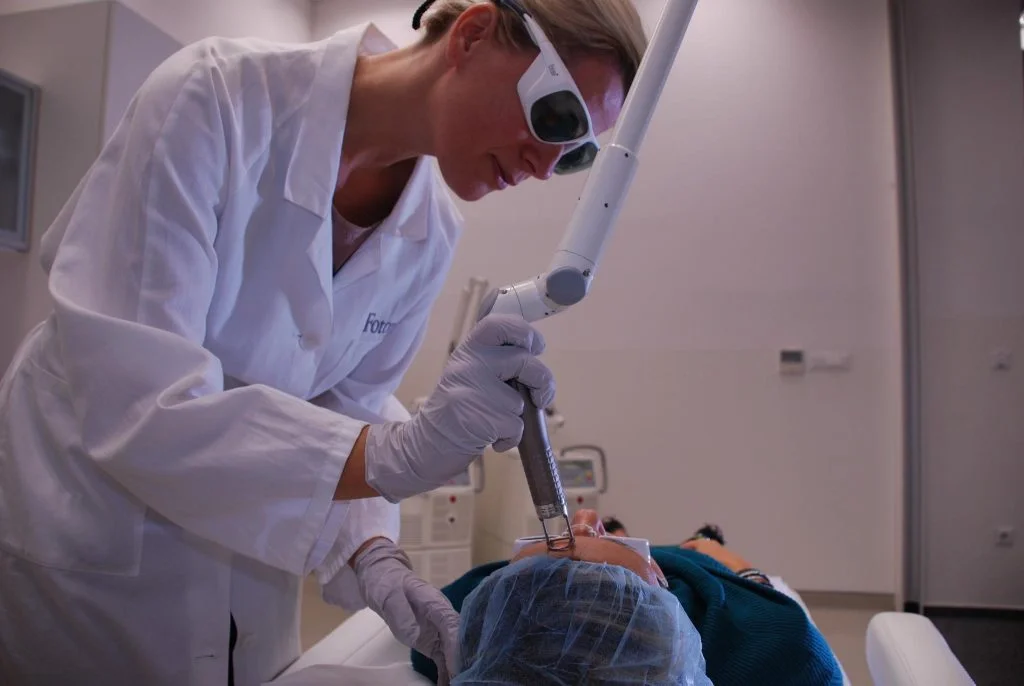
The superficial laser peel is great for removing pigmentation occurring at the outer epidermal layer and results in a more refreshed appearance with minimal downtime of 3 to 5 days.
The medium peel addresses more significant pigmentation at the deeper skin layers. Coarse skin texture can also be treated. The downtime with medium-depth peels is about one week.
Fully ablative laser resurfacing
The fully ablative erbium laser peel is a deep laser resurfacing treatment performed only by a dermatologist. After a skin preconditioning protocol for six weeks, the laser is performed to the depth of the dermal level, fully ablating the epidermis. Even severe hyperpigmentation, coarse skin texture, fine lines, and wrinkles are treated. Fully ablative laser peels are not advised in those with darker skin types due to the risk of aggravating hyperpigmentation. The downtime after fully ablative laser resurfacing is approximately two weeks.
Before and after fully ablative Erbium laser resurfacing:
The CO2 laser is an older type similar to the Erbium YAG laser because it is ablative. The CO2 laser only applies to light-skinned patients and can only be performed as a fractional laser treatment. This is because CO2 laser carries significant risks of scarring and hyperpigmentation. At Centre for Surgery, the CO2 laser has been superseded by state-of-the-art Erbium laser resurfacing for hyperpigmentation.
Hyperpigmentation Treatment in London: Excellence at Centre for Surgery
Centre for Surgery in London stands as a beacon of excellence for hyperpigmentation treatment. Our clinic combines advanced technology with expert medical professionals to provide bespoke treatments tailored to each patient’s unique skin needs. We pride ourselves on our meticulous approach, ensuring that every patient experiences a significant improvement in their skin condition.
Patient Testimonials:
- “I struggled with hyperpigmentation for years and felt self-conscious about my appearance. The team at Centre for Surgery changed my life. Their personalised treatment plan significantly faded my dark spots and evened out my skin tone. I’ve never felt more confident!” – Sarah, London
- “The results I achieved at Centre for Surgery were beyond my expectations. Their understanding of skin conditions and the latest treatments is unparalleled. My skin looks rejuvenated, and my hyperpigmentation has visibly reduced.” – Raj, Birmingham
- “Finding Centre for Surgery was a turning point for my skin health. The professional and caring approach of the staff made a huge difference. I’m thrilled with the results of my treatment, and my skin has never looked better.” – Emma, Bristol
Booking a Consultation: To begin your journey to clearer, more radiant skin, we welcome you to book a consultation with our expert team. Contact us at:
- Phone: 0207 993 4849
- Email: contact@centreforsurgery.com
- Address: 95-97 Baker Street, London W1U 6RN
Discover More About Us: Learn about our commitment to patient care and the advanced treatments we offer by visiting our About Us page.
Flexible Finance Options: We believe in making our treatments accessible to everyone. Explore our finance options, including 0% APR with Chrysalis Finance, on our Finance Options page.
Additional Information: For insights into the latest advancements in skin care and aesthetic treatments, read our informative Plastic Surgery Blog.
Frequently Asked Questions and Clinic Details: For answers to common queries about our treatments and services, please visit our Clinic FAQs. You can also learn more about our Baker Street Clinic here.
At Centre for Surgery, your skin health is our top priority. We are dedicated to providing you with the highest standard of care for hyperpigmentation treatment, ensuring you leave our clinic with a renewed sense of confidence and well-being.
